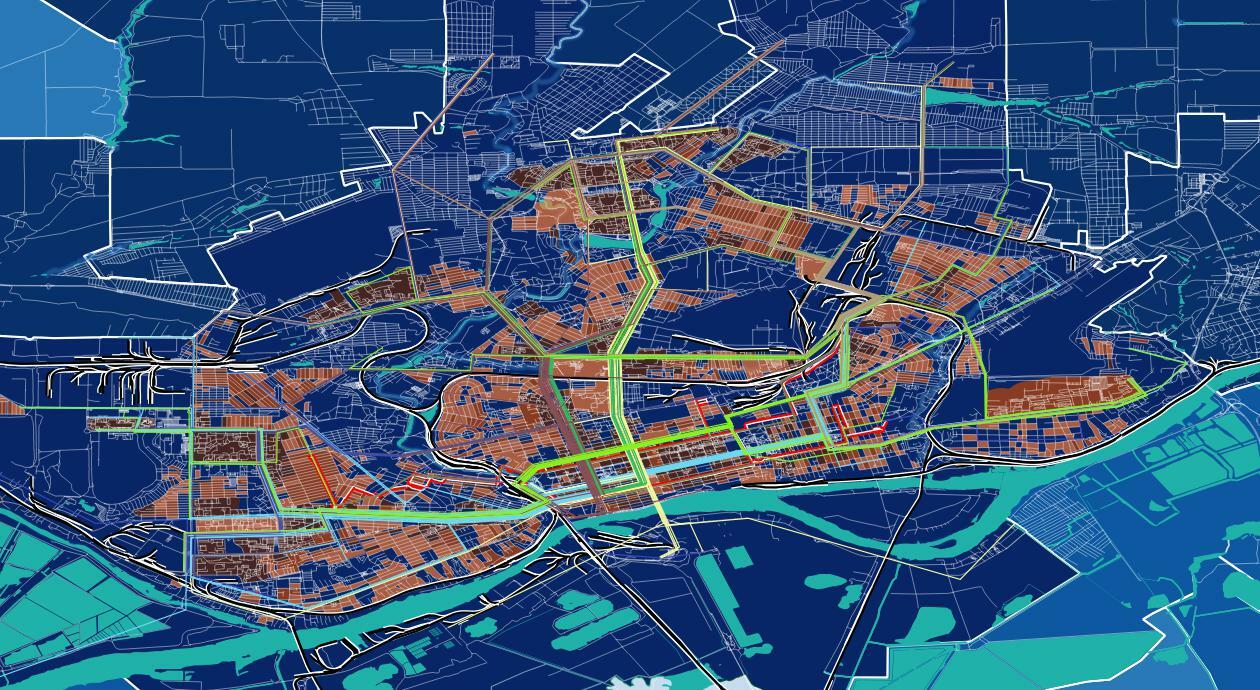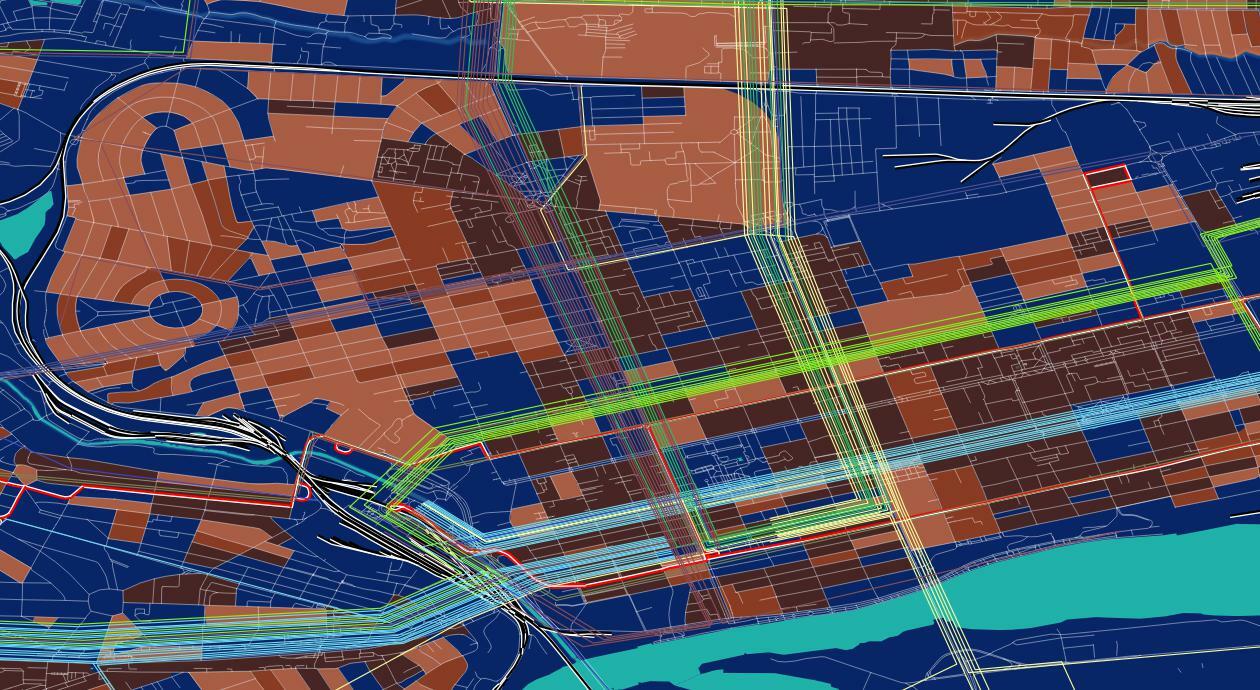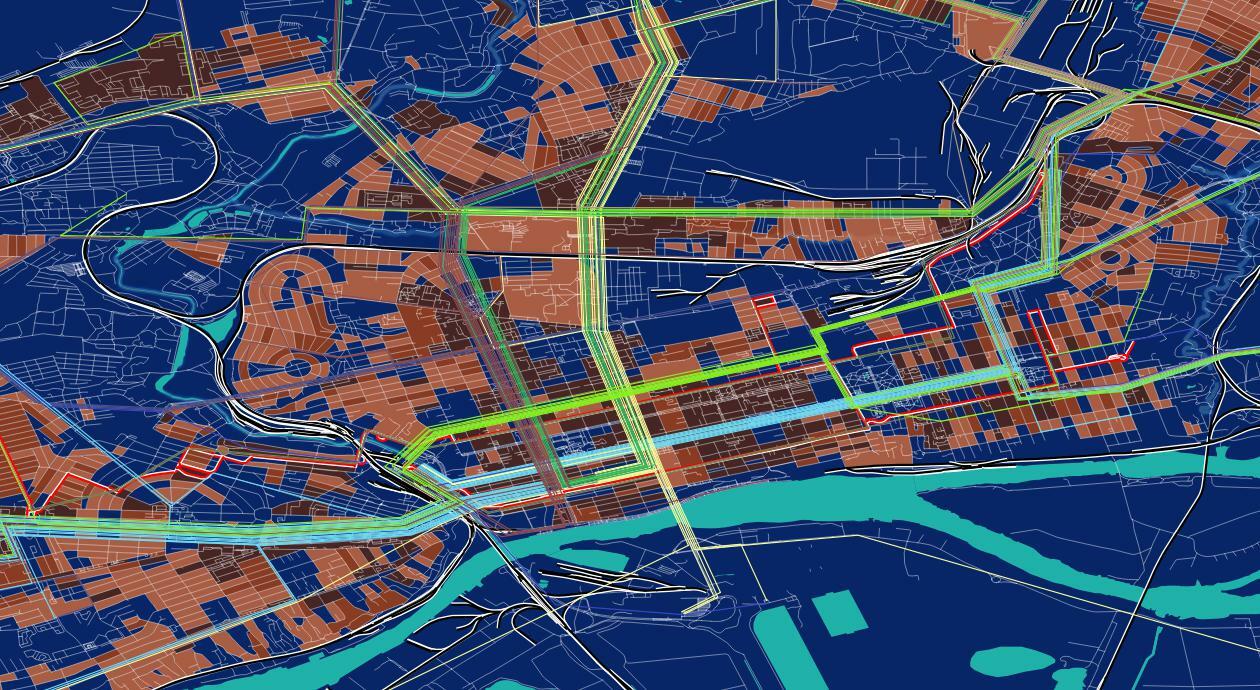Transport strategy.

In 2018, the Urban Factory team was involved in the development of the strategy of the city of Rostov-on-Don and the Rostov Region in terms of the urban development, in particular the transport development.
The road transport complex is one of the basic components of the spatial framework of the city of Rostov-on-Don. It is represented by intercity passenger transport and the municipal road transport network. During the work, his condition was assessed and development trends were identified.
The key problems are the insufficient capacity of the existing road transport network, as the growth in the number of vehicles outstrips the pace of development of the city’s road network. The load on the road network, taking into account transport entering the city (including transit), is 508 cars per hour. The peak transport load at the main entrances to the city is 18-20 thousand cars per hour, in the central regions it is 2 times higher. The density of roads in the central part of the city is 4.2 km / km2, which exceeds the standard by 1.7 times.
The capacity of streets in the central part of the city is reduced due to the use of streets for parking vehicles due to the lack of effective management of urban parking space.
Infrastructure for non-motorized modes of transport in the city is underdeveloped.
The problems include the decrease in the attractiveness of public transport in favor of personal passenger transport (transport imbalance)
Recently, the level of motorization has grown by almost 5 times and is currently (excluding transport arriving from regions and satellite cities) about 420 cars per 1,000 inhabitants. Passenger transport of urban traffic totals 1,636 units of rolling stock, including high-capacity buses – 687 (42.0%), low-capacity buses – 840 (51.4%), trolleybuses – 53 (3.2%), trams – 56 ( 3.4%).
However, a number of problems remain that adversely affect the attractiveness of public transport, including the loss of time at stops; early shutdown of public transport; outdated rolling stock; low level of comfort and safety (passengers filling in excess of the norm, unsatisfactory technical and aesthetic condition of a part of the rolling stock); increased financial load on passengers (including the lack of a flexible tariff menu, payment for each transfer, underdeveloped non-cash fare); imperfection of the route network (including duplicate routes, inconsistent schedules, outdated routing methods, etc.); inefficient organization of centralized public transport management (including the lack of an intelligent transport system).
Moreover, the movement of public transport along the street-road network as part of the main automobile stream significantly reduces its operational speed and communication speed, especially during busy hours. Dedicated lanes for public transport are inefficient.
The need to update the route network of electric transport, since the city transport system of Rostov-on-Don as of the beginning of 2018 includes 172 bus routes, 49 route taxi routes, 5 trolleybus and 5 tram routes. The route network of the city is 3,681.9 km; the main share (more than 93%) is the bus network. However, under the current conditions of territorial development and development of the city, it is necessary to consider the issue of opening new electric transport routes. The current route network of electric vehicles does not currently cover new areas of the city. The length of tram tracks is extremely low.
Today, the establishment of public transport priority in large cities can surely be called a key trend. Public transport is becoming an integral element of large cities. The territories of urban historical centers are exempted from multi-level interchanges built in past years in order to satisfy the ever-growing demand for car mobility. Today, large cities prefer new lines of public transport, especially rail, the development of areas of limited automobile access and bicycle infrastructure. Initially, these trends appeared in Germany, the Netherlands, and Scandinavia. Today they can be considered universal for all developed countries.
The attractiveness of using public transport is growing, primarily due to the development and integration of rail transport systems of various types – from traditional subways, trams, suburban rail lines to modern types of light rail transport (LRT).
Ubiquitous urbanization and motorization lead to overload, and in the long run to the collapse of the transport systems of megacities and large cities. The growth of congestion on the roads reduces the quality of life, labor productivity, has an adverse effect on the environmental situation and public health. Which raises the demand for the introduction of conceptual transport solutions in urban infrastructure.
In this regard, there is a growing demand for “smart” mobility and the introduction of intelligent technologies that allow organizing traffic flow with maximum comfort and safety for city residents. The priority area is the reduction in the number of vehicles in cities, including due to the spread of alternative modes of transport (bicycles, microelectrotransport, etc.). Smart mobility increases the comfort, economy and environmental friendliness of living in the city.
The development of rail public transport as the main one was proposed as it includes all the necessary parameters. The Urban Factory project of expanding the tram network and the development of both the infrastructure and the economy around it were taken into account, which became one of the main points of the strategy document regarding the transport development of the city.
Urban Development and Light Rail Transit
The implementation of light rail transit (LRT) has great potential to influence urban growth and revitalize a city’s area. It can strengthen existing neighbourhoods, rejuvenate declining areas and attract new clusters of development around station sites. Development investments affected by the implementation of a LRT system can include the creation of new housing, offices and shops. Furthermore the development of LRT systems can have an immediate influence in directing where, how and what kind of growth can take place. The implementation of LRT can also assist with increasing population and employment densities adjacent to the line and specifically in the vicinity of LRT stations. Yet in order to reap these economic development benefits, appropriate land use and political policies must be in place to optimize the return on investment.
Land Values and Light Rail Transit
The effect of light rail transit (LRT) on land values is something that can begin to develop as soon as the decision to move forward with the implementation of a system is announced and typically continues through the actual planning of the system and after the system is in place. Many studies indicate that land values increase at LRT station nodes one year before station construction begins or approximately three years after station plans are announced. It was also found that plans for LRT improve the coordination of public and private investments which can improve social welfare with increased investment and direct spending into dedicated transportation infrastructure. As land proximity to stations increases, so does the land value. These higher land values discourage low density development in favour of high density residential and commercial development. In addition, local government can benefit from light rail’s additional value such as increased property taxes, benefits assessment programs and joint development initiatives. The economic value of light rail should further take into account the resultant revenue streams which occur due to increased access, increased land values and public-private partnerships in developments along transit nodes. Indirect benefits such as increased property taxes and direct benefits such as public-private partnerships or betterment taxes translate into revenues for the municipal sector. When this is coupled with provincial and federal investment in capital, light rail is a feasible and desirable transit option.
Municipal Benefits of Light Rail Transit
Implementing light rail transit can have numerous positive effects on the local economy. The external costs of automobile use, such as air pollution and congestion, are proven to negatively impact the economy. A market value which fails to account for externalities does not provide the market with the proper information to base decisions on; which can severely impact natural resources and the economy. If the total costs of car travel were charged to the vehicle owner, the costs of travel would outweigh the benefits, considerably reducing the motorist’s willingness to pay. Currently, a significant portion of automobile economic externalities are charged to municipalities and tax payers. The use of light rail transit helps to eliminate these externalities by decreasing the need and benefit of auto use, in favour of accessible transit. Furthermore, servicing populations in the outlying areas of the city with efficient transportation systems such as light rail transit will help lessen dependence on the automobile. Rostov-on-Don, like most Russian cities, occupies a large area comprised of outlying communities which are disconnected from the downtown core and have limited bus service. This type of urban development increases dependence on the automobile and has negative impacts on the City’s downtown core. Controlling the growth in car use, through transit oriented development and light rail networks, can therefore improve the municipal economy by bringing people to the core and revitalizing areas around transit nodes, along rail corridors and in related residential and commercial developments that are near walkable, bikeable, transit connected networks. Study of the city shows that light rail and transit oriented development increase access to municipal, commercial and employment areas. A well planned and convenient transit system has the ability to attract new ridership by improving accessibility. This expanded source of income can help fund the day to day operation of the system and sustain future upgrades and maintenance. LRT also has a great effect on employment and lifestyle which is part of a larger movement towards smart growth and transit oriented development in city planning and streetscape development. Light rail transit can help satisfy the needs of employers who require access to a large pool of employees and employees who want to live in urban areas that are close to their places of employment. This new and developing trend has made some companies re-evaluate their strategy to build campus-style workplaces on the outskirts of city centres and begin to consider urban offices located within the central business district of a larger municipal centre. The economic success of the City of Rostov in the coming years will depend less on its manufacturing base and more on its academic and technical industry. The strategies to attract a cultural and creative workforce, which will become a key component to building this new economy, depend on the ability of the City to attract and retain workers and employers. Downtown core renewal, heritage building preservation, smart growth, inner urban area investment, space conversion, park and trail design, efficient rapid transit and growth in the entertainment and tourism sectors are amongst the list of strategies necessary to attract and retain a creative workforce. Rostov’s rapid transit strategy, coupled with development planning will help move the economy into an era of prosperity and civic-oriented lifestyles.
Results of the Analysis
Light rail systems have consistently proven, through research, that they are a powerful influence in terms of attracting new economic development to transit corridors and central business districts. A city that has dedicated itself to permanent public transit infrastructure is viewed as one that takes development seriously, and this is what attracts new riders, developers, employers and tourists to the light rail corridors. Not only are light rail vehicles economically sound, they are also environmentally sustainable and lead to less noise pollution and lower green house gas emissions. These advantages make light rail transit systems a feasible solution for transportation corridors that are designed with transit oriented development guiding principles. LRT could be the catalyst required to move Rostov forward in its economic development strategy.


Copyright © I privacy policy
Urban Factory | Powered by MAVEK dizajn